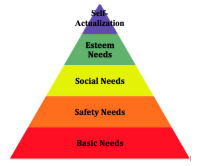|
 I
hope you’ve had a chance to read last month’s article on the first
three lower-level needs. If you did not, click HERE. I
hope you’ve had a chance to read last month’s article on the first
three lower-level needs. If you did not, click HERE.
This month we tackle the upper
two levels of esteem needs and self-actualization.
Maslow’s fourth level in the
pyramid is all about respect. (Yes, Aretha had it down pat.) People
want to be respected and esteemed by others. There are two types of
respect: external and internal.
External respect is the
lower order esteem need. You might say this is the need for
status, recognition, and prestige. We want to be valued and accepted by
others. This could come in the form of attention, reputation, dignity,
and even dominance over others. A person can be famous or have
national/international glory, but both require the opinions of others
(the public) to make them so.
This is considered the “lower”
order esteem need because it’s based on the opinions of others and it’s
not intrinsic to yourself. This kind of esteem can come and go, and can
certainly be lost. Just ask Tiger Woods.
Internal self-respect
is the higher order esteem need. We want to feel that we’ve
contributed something worthwhile, something of value. This includes
possessing inner strength, competence, mastery, independence, freedom,
and self-confidence. Something that we do—activities, club, our jobs,
or hobbies—or something we live through and experience gives us this
feeling of contribution and competency.
This is a “higher” order esteem
need because once you respect yourself, it’s harder to lose that
respect.
These two levels of esteem needs
aren’t a package deal. You can have one but not both. A character with
low self-esteem will not be able to improve his view of himself by
receiving accolades and fame. A narcissist would think highly of
herself, but wouldn’t have the external esteem to go with it because,
well, let’s face it. Who really likes narcissists?
When this esteem need isn’t met,
a person or character could have low self-esteem or an inferiority
complex. Helplessness, depression, or emotional weakness can also
happen if these needs are not realized.
Up
until now, we’ve been dealing with the four lower levels of Maslow’s
pyramid. These levels make up what Maslow calls the deficit needs,
because if a person doesn’t have enough of something, a deficit occurs
and she feels a need. Maslow’s theory was that self-actualization
occurs when a person not only meets the lower deficit needs, but
masters them.
When she attains
self-actualization, she reaches her full potential. Don’t think of this
as the Buddhist concept of enlightenment. Instead, think of it as
people desiring to be everything they are capable of being. This is a
broad concept for self-actualization, but when applied to individuals,
it can be very specific.
|
One
character might desire to be
an author or a good parent. Someone else might want to be a pro
football player or invent something special. When these things happen,
among others, individuals will have a peak experience, which is a
profound moment of supreme happiness. They are full of love,
understanding, and harmony. They feel whole, vibrant, and aware.
Self-actualizing people have many peak experiences.
When I started thinking about
characters in our books, this theory can dovetail off of Debra Dixon’s Goal,
Motivation & Conflict (GMC). What our character most
wants, his ultimate goal, could also be called his self-actualization.
The conflict would be the deficit needs going unmet or being derailed.
I figured the motivation to
reach a person’s self-actualization would originate from one of the
needs not being met (deficit needs)—perhaps for a long time, like a
childhood hurt of learning your birth parents gave you up for adoption,
or a lifelong hurt of never feeling safe and always having to look over
your shoulder. A person could be motivated to be the best financial
provider for his family (self-actualization) because his father left
them, so his mother always struggled to make ends meet. See how this
could fit with GMC?
I said it last month, but I’ll
say it again. Maslow had a theory. It may or may
not float your boat, or it may be a useful way of organizing and
prioritizing a character’s needs. There has been little evidence found
for why Maslow ranked the needs on his pyramid like he did. Some
researchers have found no evidence for a hierarchy at all.
One thing that is definitely
true: characters can skip around or jump through the hierarchy. One of
my blogger buddies pointed out that this theory could explain why it’s
so interesting or admirable when a character skips around on the
pyramid.
Livia Blackburne wrote, “Girls
swoon over Edward Cullen because he breaks the
expectations of the pyramid—ignoring his need for food in order to meet
a ‘higher’ need. In the same way, we admire a monk who fasts for a
month in order to get religious enlightenment. Jumping the pyramid
makes you larger than life—and in some cases, story worthy.”
I couldn’t agree more and
couldn’t have said it better myself. Give a character enough of a
motivation or conflict, and you can really play around with these
levels.


|